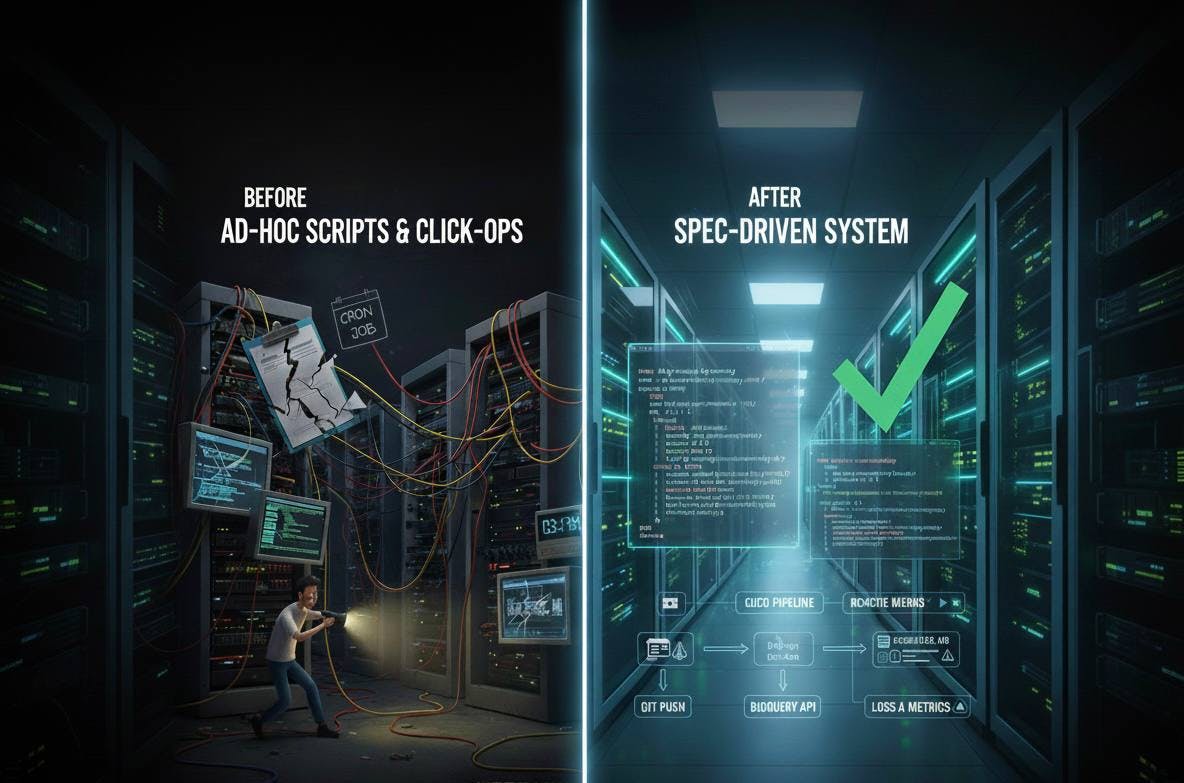1. Introduction: Writing a Query ≠ Building a System
Writing a SQL query is simple. Building a reliable system that runs hundreds of queries across multiple teams every day is not. Most teams start by:
- writing SQL in the warehouse UI,
- scheduling it with a few clicks or a cron job,
- wrapping it in a bash script when things feel “serious”.
This works until:
- new stakeholders appear,
- more tables and dashboards depend on these jobs,
- incidents happen at 3 a.m.
The problem is systemic. Poor data quality alone costs the average enterprise at least $12.9M per year (Gartner), and that’s before counting the human time spent chasing broken reports and pipelines.
Operational drag is measurable. In Monte Carlo’s industry survey, organizations reported ~67 monthly data incidents, with 68% taking ≥4 hours just to detect and an average of ~15 hours to resolve — trendline worsening year over year (Monte Carlo – State of Data Quality)
Cost risk compounds the reliability risk. Managing cloud spend is the #1 cloud challenge for 84% of respondents (Flexera 2025 State of the Cloud). In BigQuery you are charged by bytes processed (pricing), and Google explicitly recommends enforcing maximum bytes billed and using dry-run to prevent runaway queries (cost controls, dry-run)
Core issue: teams treat SQL automation as “scripts and schedules,” not as a system with clear contracts, validation, and observability.
This article explains how to move from ad-hoc scripts and click‑ops to a minimal, spec‑driven architecture that is:
- API‑first, not UI‑first;
- makes jobs reproducible and reviewable;
- enforces validation, dry‑run, and cost limits;
- adds logging and metrics so incidents are no longer blind guesses.
If you maintain dozens of scheduled queries, support analysts and ML engineers, or frequently explain “what this job actually does,” this article is for you.
2. Common Failure Modes in SQL Automation
Here are the most frequent anti-patterns.
2.1 Everything lives in the UI
- Queries are pasted directly into the console.
- Schedules are set by clicking through menus.
- Labels and metadata are optional or missing.
What goes wrong:
- No single source of truth – the job’s definition lives only in the UI.
- No history – you can’t tell who changed the query or when.
- No standards – names, regions, datasets, and labels drift over time.
The UI is perfect for exploration and prototyping, but terrible as a production control plane.
2.2 No templates, no parameters
Copy‑paste becomes the “template engine”:
- the same query pattern is duplicated across many jobs,
- only a few literals change (dates, regions, product types),
- you must edit N almost‑identical queries for any update.
Problems:
- subtle differences creep in (a missing filter here, a different join there),
- you can’t say which version is correct,
- refactoring is dangerous because you might miss a variant.
2.3 No validation or dry‑run
Typical “validation” looks like:
- change the query,
- click “save,”
- wait until tomorrow to see if it fails.
Consequences:
- parameters like
date_from/date_toget swapped or misformatted, - target tables are wrong (wrong dataset, typos),
- queries accidentally scan entire raw tables, inflating costs.
2.4 CLI wrappers and shell hacks
Someone writes bash wrappers around bq, psql, or similar. Config lives partly in flags, partly in env vars, partly in code. Problems:
- logic is spread across shell scripts, config files, and SQL,
- it’s easy to forget a flag or change behaviour in only one place,
- debugging is reading hundreds of lines of bash with
set -x.
2.5 Zero observability
Even when scheduled, jobs often have:
- no structured logs (just raw stdout or emails),
- no metrics on success/failure, runtime, or bytes processed,
- no alerts except “someone noticed the dashboard looks wrong.”
Then incidents start with: “Did the job even run?” — and no one knows.
3. What a Real System Looks Like
Instead of patching scripts and dashboards, define what “good” looks like and build towards it. A realistic target for a modern SQL automation system includes:
- API‑first. Use the warehouse API or official SDK instead of manual UI or bare CLI. Treat scheduled queries as code‑managed resources.
- Spec‑driven. Each job has a spec file (YAML/JSON) describing:
- name and schedule,
- SQL template path,
- parameters,
- destination table and write mode,
- labels and tags,
- limits (e.g.
max_bytes_billed). n Specs live in Git and go through review.
- Templated SQL. SQL is written as a template with explicit parameters, not copy‑pasted variants. Rendering is strict: undefined parameters are errors; only whitelisted parameters may be used.
- Validation before deployment. Structural validation: required fields, formats, allowed values. n Policy validation: required labels, reasonable cost limits, allowed destinations. n Business validation where possible: naming conventions, retention rules.
- Dry‑run and tests. Dry‑run every change to catch syntax errors and estimate cost before deployment. For critical tables, run basic data tests (schema assumptions, quality checks).
- Deployment via CI. When a spec or template changes, a pipeline:
- validates the spec,
- renders the query,
- runs a dry‑run,
- if successful, creates/updates the job via API. n Rollback = revert the merge.
- Built‑in observability. The system logs when jobs run, whether they succeed or fail, runtime, and bytes processed. Metrics feed into monitoring, and alerts fire on failures and anomalies.
Even this “minimal” system is a huge improvement over “UI + cron + bash”.
4. Minimal Architecture: From Spec to Job
Implement the concept step by step over a couple of sprints.
Step 1: Define a job spec
Example job-spec.yaml:
name: daily_revenue_by_country
schedule: "0 3 * * *"
sql_template: "sql/daily_revenue_by_country.sql.j2"
destination_table: "analytics.daily_revenue_by_country"
write_disposition: "WRITE_TRUNCATE"
labels:
owner: "analytics"
domain: "revenue"
environment: "prod"
parameters:
days_back: 1
limits:
max_bytes_billed: 50000000000 # 50 GB
This file:
- provides a single source of truth,
- makes the spec readable by both people and machines,
- forces you to define owner, domain, environment, and limits.
Step 2: Validate the spec
A minimal validator should:
- ensure required fields exist (
name,schedule,sql_template,destination_table,labels.owner,limits.max_bytes_billed), - fail if:
- there is no
environment, - the limit is missing or too large,
- the name doesn’t follow conventions,
- the schedule is invalid (e.g., runs too frequently).
Use JSON Schema, Pydantic/dataclasses, or your own validator. Crucially, validation must happen before deployment and be part of CI, not a manual checklist.
Step 3: Render the SQL template
Template daily_revenue_by_country.sql.j2:
SELECT
country,
SUM(revenue) AS total_revenue
FROM raw.orders
WHERE order_date >= DATE_SUB(CURRENT_DATE(), INTERVAL {{ days_back }} DAY)
GROUP BY country
Rules:
- Every parameter must be listed under
parametersin the spec. - If the template uses an undefined parameter, treat it as an error.
- Never build SQL via string concatenation in code—always use a parameterized template.
Step 4: Dry‑run and basic checks
Before creating or updating a job:
- Run a dry‑run via the API:
- check the query compiles,
- get an estimate of data volume and cost,
- compare it against
limits.max_bytes_billed.
- Optionally run quick data checks:
- for critical tables, ensure they aren’t empty or full of unexpected nulls.
If the dry‑run or validators fail, CI blocks the merge.
Step 5: Deploy via API
If all checks pass:
- Call the warehouse API (e.g., BigQuery) to create or update the job.
- Pull the job name and labels from the spec.
- The deployment is idempotent: the same spec always yields the same configuration.
There are no manual UI edits or one‑off jobs.
Step 6: Observe and iterate
The system should:
- log the job name, start time, status, duration, and bytes processed,
- push metrics into your monitoring system,
- trigger alerts on failures, cost spikes, or missed runs.
Over time, you’ll see usage patterns, identify expensive queries, and decide when to refactor based on data, not hunches.
5. Before and After: Typical Improvements
- Before: Jobs created and edited via the UI, no history, no standards. n After: Jobs defined as specs in Git; the UI is only for exploration.
- Before: Copy‑pasted queries with tiny differences. n After: SQL templates with explicit parameters and a single source of truth.
- Before: Parameters regularly break data (wrong dates, wrong tables). n After: Spec validation and strict template rendering with dry‑run before deployment.
- Before: Shell wrappers around CLI tools, hard to debug. n After: A small service or library calling official APIs with structured logs.
- Before: Migrating jobs between projects/regions is manual pain. n After: Specs are re‑deployable in new environments with minimal changes.
- Before: Nobody knows which jobs exist or who owns them. n After: Each spec includes
owneranddomain; the list of jobs equals the list of specs. - Before: Incidents start with “did the job even run?” n After: Logs and metrics show when, how long, success/failure, and cost.
The root cause in almost every “dirty” system is no explicit contract and no source of truth. Once you have specs in Git, validation, and dry‑run, chaos drops dramatically.
6. Conclusion: Build It Right Once—and Stop Fighting Fires
Manual SQL automation:
- accumulates technical debt,
- dilutes accountability,
- makes cost and risk unpredictable.
Key ideas:
- Treat jobs as code, not UI state. Specs in Git plus review give reproducibility and history.
- Never deploy raw, unvalidated SQL. Templates plus strict parameterization plus dry‑run.
- Make policies executable. Labels, limits, allowed destinations are checked automatically, not just by convention.
- Use CI for deployment. Deployment is a pipeline, not a local command run in someone’s terminal.
- Invest in observability early. Logs and metrics for jobs are cheaper than fixing broken reports at night.
You don’t need a massive orchestrator. A small, focused system that converts SQL jobs into specs, validates them, and deploys them via API is enough to go from “we hope it runs” to “we’re confident the system behaves predictably.”
Full reference implementation:
https://github.com/timonovid/bigquery-sql-automation











